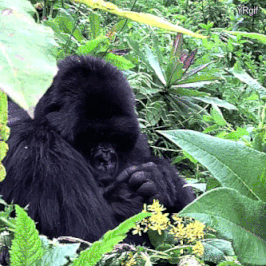The following spoken words were done by Koko the Talking Gorilla…
I am Gorilla
I am flowers, animals, and I am nature.
Man Koko love!
Earth Koko love!
But man stupid.
Stupid!
Koko sorry… Koko cry!
Time hurry.
Fix earth! Help earth!
Hurry!
Protect earth.
Nature see you.
Thank you!
Life on earth continues to fascinate me to no end. From the abomination of the platypus to the sheer brilliance of humans; our world is filled with such wonderful beings.
Mountain gorillas. They would fall under one of my favorite animals to ever grace this earth. As much as I would like to talk about how funny and cute they look, it would undermine many of their unique features. They are intelligent, gentle, and they are like us. The male gorilla leads a cohesive family, which they will protect. They will charge and make themselves larger to instill fear into any predators that may harm their young. Even if it means putting down their own lives, family comes first for the male mountain gorilla. Yet, they are as gentle as their female counterpart since they support their young during the time of weaning. Furthermore, when the young are old enough (around 11 years old) they leave their biological family to start their own. They tend to travel for quite some time, either alone or with others, until they find a female to start their own family with.
A mountain gorilla’s life mirrors our own to every minuscule detail; however, we treat them as a distant creature with little to no resemblance to us. We are the directly responsible for their decline in numbers, yet we are so oblivious to it. For instance, their population is currently under 900 individual gorillas. We play into their decline in numbers under three factors.
Gorillas have lost their homes to humans who have cleared their land for agriculture and livestock. Illegal settlers claimed thousands of acres of land from one of the world’s most abundant source of mountain gorillas: Virunga National Park. They house a quarter of the population in a miniature park only 1.2x the size of Banff National Park here in Alberta.
Although viewing the mountain gorilla in person at the park is a magnificent experience, humans are generally unaware of the harmful diseases that can be transmitted to these gentle giants. The issue arises when it was discovered the gorillas are susceptible to the same illnesses as humans but in far more severe forms. What could be a minor inconvenience to you or myself, can be lethal to a gorilla.
We are told our colds will fade away if we simply ingest a mug of milk and honey every so often. However, if they get our colds, they worry about the loss of a mother or a child. The father may survive, but his odds of survival don’t look any better than his family.
Lastly, Central Africa has been ravaged by war and conflict for many years. Regretfully, the gorillas have found themselves caught in the crossfire of these wartorn countries. Paranoia has driven the people to set traps and landmines for their enemies; however, what they caught were the sons of families looking for a partner to continue a species that may disappear in our lifetime.
Those who know, worry. However, those who worry will do what is in their power to save the mountain gorilla. In recent years, the population of the gorillas has been increasing much in part to the works of conservation experts and the locals from villages and park rangers. The grace of music has blessed the region of Virunga, and WWF (World Wildlife Fund) has teamed up with local artists from the region to help raise awareness through this song.
In addition to raising the spirits of the locals through familiarity, the song promotes tourism in the sense they emphasize that mountain gorillas the attraction many foreigners seek. If they are to attain a stable economy, they musn’t dismantle their ecotourism industry, as it would devastate their economy. Furthermore, locals to the gorilla’s land are being better educated with regards on how to approach a gorilla:
- Remain at least 7 meters away from any gorilla.
- Any traps found in their land should be removed.
- Patrols around gorilla homes should be constant.
- Monitor gorilla population.
- Support orphaned gorillas by supporting Kariosoke Research Centre.
(We need not fear our distance and separation from them. There is still so much we can do to save them. Donating is perhaps the biggest help you can provide to directly support the species! You can support them here or maybe even here! Or you could treat yourself and visit the beautiful Virunga National Park in Africa to fund the ecotourism industry.)
